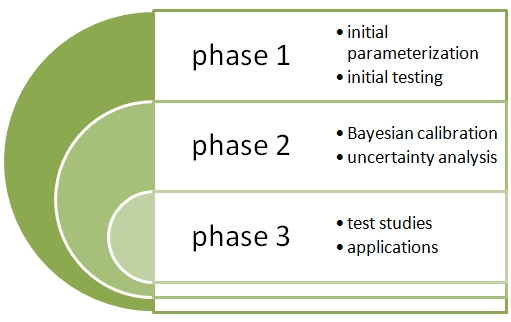Note that this page is part of a collection of iLand history pages and does not necessarily represent the current state of model development!
We see model development as a continuous cycle of various phases and steps with feedbacks and interactions between all of them (cf. Grimm and Railsback 2005). iLand development advances in three phases, from initial parameterization and testing to large scale Bayesian calibration and evaluation in specific application cases.
The overall iLand model design corresponds directly to its intended domain of application. Process resolution and level of complexity are selected accordingly, yet taking feasability of implementation in the project duration into account. An initial model design overview can be found here.
Phase 1
Phase 1, the initial development and parameterization of the model, is a hierarchical sequence of seven steps with frequent feedbacks and links to previous steps. The stepwise design embraces a bottom-up approach, starting from the interactions between individual trees and incrementally adding higher level processes.
Step 1: individual tree competition for light
- Focal processes and entities: light resource index (LRI) for relative competitive strength of the individuals for light resources, field of neighborhood patterns
- Scale: individual tree, stand
- Parameterization: crown shapes, allometric equations for biomass compartments
- Evaluation: available light per individual compared to PICUS and SORTIE light models for various stand structures; forest floor light patterns
- Objective: light resource index established and evaluated
Step 2: tree growth relations, controlled environment
- Focal processes and entities: NPP, allocation, tree morphology, density-dependent mortality, base management (simple removal of trees at stand level)
- Scale: individual tree, stand
- Parameterization: literature values for QUE, respiration, allometric equations; yield table data and published values for tree morphology (h/d relationships); tree species silvics (e.g., shade tolerance)
- Evaluation: literature values for stand level productivity, yield table data, tree shapes and taper, Yoda & Reinekes power laws and observed stem numbers
- Objective: dynamic individual tree growth relations established, maximum tree dimension under optimal environmental conditions achieved
Step 3: environment
- Focal processes and entities: water cycle, soil resource index (SRI) for relative competitive strength of the individuals for soil resources, environmental response functions for growth, environmental thresholds for mortality
- Scale: stand, landscape
- Parameterization: tree species silvics, prior model parameters (ZELIG, ForClim, PICUS), literature, empirical data (according to availability)
- Evaluation: plant available water, growth relationships, strand structures and compositions under different environmental conditions
- Objective: realistic environmental sensitivity of processes growth and mortality established, realistic site water differences as emerging property of iLand
Step 4: regeneration
- Focal processes and entities: regeneration
- Scale: stand, landscape
- Parameterization: tree species silvics, prior model parameters (ZELIG, ForClim, PICUS), literature, empirical data (according to availability)
- Evaluation: natural species composition, successional dynamics, spatial regeneration patterns
- Objective: regeneration niches modeled, ecosystem dynamics at landscape level (sans disturbances and management)
Step 5: soil carbon
- Focal processes and entities: soil C cycle,
- Scale: stand, landscape
- Parameterization: literature
- Evaluation: (equilibrium) belowground C pools
- Objective: soil pools and dynamics established
Step 6: management
- Focal processes and entities: management
- Scale: individual to landscape
- Parameterization: literature, management records, management concepts
- Evaluation: management patterns and effects, empirical data (according to availability)
- Objective: ecosystem dynamics in managed landscapes
Step 7: disturbances
- Focal processes and entities: fire, insects, wind
- Scale: stand, landscape
- Parameterization: literature, empirical data (according to availability)
- Evaluation: landscape patterns, empirical data (according to availability)
- Objective: ecosystem dynamics including disturbances
